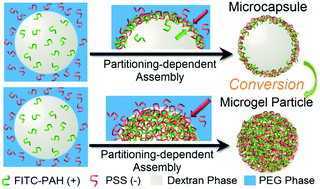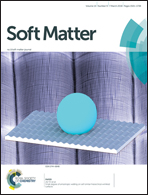Partitioning-dependent conversion of polyelectrolyte assemblies in an aqueous two-phase system†
Abstract
Partitioning refers to the distribution of solute molecules in the two immiscible phases of a mixture of two solutions, such as an aqueous two-phase system (ATPS). The partitioning of RNA and peptide has been adjusted in situ to facilitate their assembly into intracellular membraneless organelles. Despite the immense potential of this approach in artificial systems, a partitioning-dependent assembly of macromolecules has been limited, due to the sophisticated processing associated with their in situ modification. Here we demonstrate an approach to direct the assembly of polyelectrolytes in an ATPS through varying their partitioning via pH changes. Microcapsules can be converted to microgel particles as the polyelectrolytes selectively partition to different emulsion phases when changing pH. Such partitioning-dependence can also be equally applied for complexing hydrophilic nanoparticles with polyelectrolytes in an ATPS. By enabling access of hydrophilic materials across the aqueous interface freely, the ATPS allows modification of their intrinsic properties in situ; this advantage will inspire more versatile control over the partitioning of hydrophilic materials and will create new multi-functional biomaterials.



 Please wait while we load your content...
Please wait while we load your content...